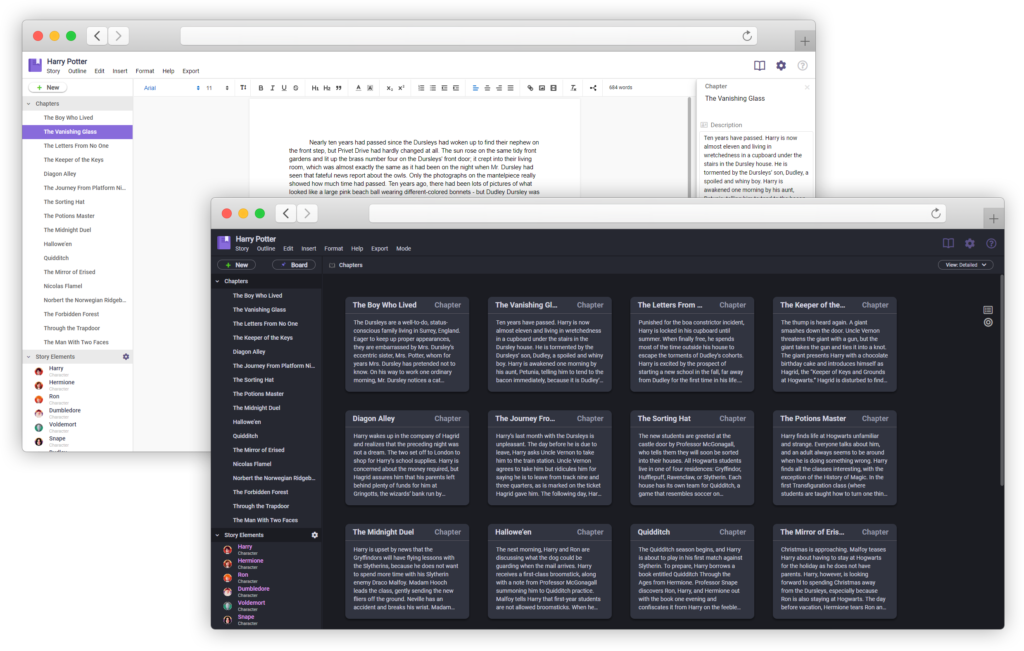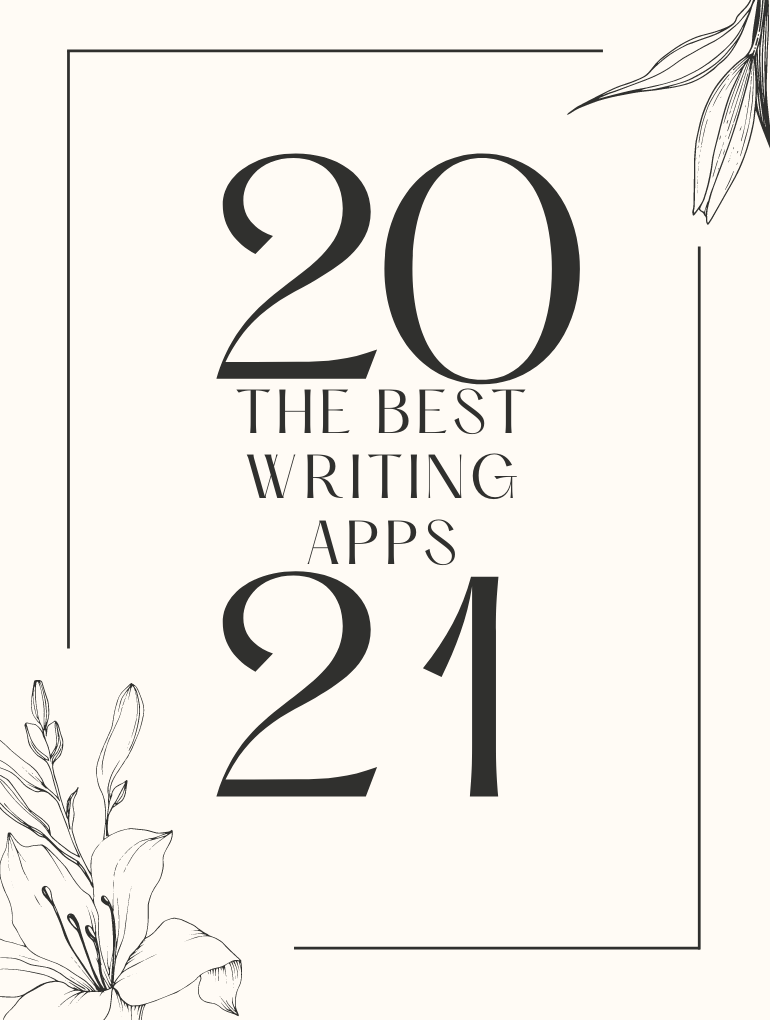Long Story Short, the Best Writing Apps in 2023 are:
It’s not an easy thing sifting through writing apps and book writing software. Especially when reviewing something you’ll be using to write your novel, it requires some time investment!
To separate the useful from useless, I’ve had to spend quality time with them (and also pay for some of them). What I was looking for here is an app or software that helps you write easier and faster. Not just something that checks your spelling or turns off other apps to keep you focused. I’m talking about a full-scale word processor like Google Docs but is tailored towards writing something more than documents.
Something like your books or your screenplays.
We didn’t find many that we’d recommend. A lot of the ones on the market are mostly just software with very specific features, like distraction-free writing or grammar checking. Some of the newer ones are just plain bad and seem like rushed jobs.
With all the technology in the world, it’s about time technology helped us write!
Out of all the software we reviewed, we found four that we’d recommend as well as some honorable mentions.
LivingWriter – The Best Book Writing Software of 2023

LivingWriter is actually new to the scene (launched in 2018). It seems like they gathered all the best features of writing apps in the past and melded them all into one. One thing I have to point out right away about LivingWriter in comparison to other writing apps, it’s beautiful!
LivingWriter made it to the top of our list because it has all the features (and more) of Scrivener with a really modern and clean user interface. It also tops Scrivener in its ability to live edit (co-author) and share your stories with friends/editors and the fact that it’s a cloud-based application rather than a desktop one.
Their story elements are wonderful to work with, I love seeing my characters in their nice tidy place. The outlines and templates (some I knew, some I didn’t) work well right off the gate to get you started with your writing. I’ve been using a template to quickly plot out any ideas that might pop into my head.
LivingWriter is completely cloud based. Meaning your writing is saved constantly to the cloud (just like Google Docs). I’ve never had any issues with it losing my writing or stories (issues that I have definitely had with other writing apps in the past).
LivingWriter is not tailored for screenwriting, but it’s our top pick for novels, short stories, and honestly any other types of writing. It also works very well for organizing blog posts and other types of professional or schoolwork.
In 2020 they’ve also released an iOS and Android app so you can write on the go.
It’s easily the best writing app out there now. Try it out! It’s abundantly clear. Check out our full review here.
Features
- Sidebar separates your chapters, subchapters, and story elements
- Drag and drop chapters and subchapters to reorganize
- Easy access, organization, and detailing of all your story elements (characters, themes, locations, etc)
- Detailing of story elements includes photos, description, notes, and history
- Smart Text Feature that recognizes your story elements and auto-suggests them as you type. This also hyperlinks the word to pull up all your notes and descriptions of the story element. No other book writing software has this feature, by the way.
- View and edit all of your notes and descriptions on the right sidebar
- Option to collapse sidebar for a full-screen view
- Import from Docx and Doc files
- The option to view all of your scenes and chapters on a “virtual corkboard”
- Pre loaded template of time tested novel writing outlines such as (Three Act Structure, 27 Beat Chapter Plotting, Dan Harmon’s Story Circle, etc) with easy guidance on how to fill them in with your ideas
- Share the whole story or separate chapters
- Live collaboration with anyone you share your story with
- Auto save every keystroke to the cloud with exponential storage and backup
- Revision history saved every few 10 minutes
- Name each revision history
- Export to Amazon manuscript templates, PDF, docx
Pros
- The cleanest interface of all the writing apps with the most user-friendly (modern) UI UX design
- Easy free trial and sign up process. There’s no downloading a program, you just sign in and start
- Feature dense for writing books with smart text, outline templates, story elements, etc.
- Cloud-based and autosave every keystroke
- Easy live collaboration with anyone you share your story with
- Companion apps for iOS and Android
Cons
- Not tailored to screenwriting.
Click here to try LivingWriter
Free for 14 Days then $9.99/month
Scrivener
$49.00
Free 30 Day Trial

Scrivener is similar to LivingWriter in terms of features, but there are a few major differences. Scrivener isn’t web or cloud based so you can’t access your work from just any device. You can only sync your files if you use a third-party storage service.
There’s also no co-author or editing capabilities with Scrivener.
The other reason we put Scrivener is number two instead of number one is because the interface is fairly confusing and outdated. it isn’t nearly as user friendly as LivingWriter. You would need to watch YouTube videos for instruction on how to utilize all the tools. There is a tutorial however it reads like a manuscript and is very long.
That being said, aside from LivingWriter, it does have a lot of great features and is still one of the best writing apps out there.
Features
- Separates scenes and chapters
- Import from Word and OpenOffice documents, plain text files, Final Draft scripts, images, PDF documents, movies, sound files and web pages
- The option to view all of your scenes and chapters on a “virtual corkboard”. You can rearrange them on a timeline as well
- The outline shows chapters separate from subchapters
- Drag and drop chapters and subchapters
- Create your own templates, MLA, and APA, novel, a novel with parts, screenplay, documentary script, BBC taped drama
- Scriptwriting formatting
- View documents side by side
- Full-screen writing mode
- Set word or character targets
- Export to Microsoft Word, RTF, PDR, OpenOffice, Epub, or Final Draft format.
- Auto save into your individual program
- Option to purchase a mobile version
Pros
- Available for Windows and iOS
- Many templates to choose from
- Feature rich for writers of all types
- Most used book writing software (due to how long it’s been around)
Cons
- Outdated and somewhat confusing interface. Bigger learning curve than the rest.
- You have to pay extra to update the software
- If you want to download on Mac, PC, and your phone then you have to buy three different versions
- No web app
- No Android app
- No collaboration features, such as co-authoring tools or the ability to share a file with someone and let them add comments or make suggestions
- You can only sync your files if you use a third-party storage service, and only between devices that have the Scrivener app installed. If need to use someone else’s computer, you can’t access your work
Final Draft

$250.00
Free 30 Day Trial
FinalDraft is not our top pick overall for best writing apps because it has a very outdated and confusing interface. You really need to watch some videos to understand how to use the features. Plus, editing and co-writing is complicated and can only be done with other people who have purchased FinalDraft. I guess it’s a little unfair to list FinalDraft here in comparison with the other apps, it’s not necessarily book writing software but rather screenwriting software.
But, it is the top pick for serious screenwriters. I emphasize “serious” because it costs a whopping $250 and it’s incredibly packed with features that will only be needed if you’re writing a screenplay that’s actually being picked up.
Features
- Formatting tools specific to screenwriting
- Auto suggest for dialogue
- Navigator window for scenes, script notes, characters, and tags (script day, location, makeup, cast members, etc)
- Script templates such as Cole Haag or Warner Brother, Dramatists Guild Musical template. Also for different graphic novels, half-hour sitcom, or one-hour TV drama
- Story Map shows the length of your script in pages, as well as your current position among those pages
- Beat board which is basically a virtual corkboard. You can drag these scene cards into the story map
- Split screen views
- Collaboration with others that own Final Draft
- Auto save every 15 minutes
- Revision history saved to a local folder on your computer
Pros
- The most tools, options, and templates for screenwriters
- Many view options
Cons
- Auto draft only saves every 15 minutes, not every keystroke
- The price is higher than all other apps
- Very complicated to collaborate and all the collaborators must own a copy of Final Draft.
- Not book writing software so not good for books at all.
Storyist

$59.99 only for Mac
Free Trial
The reason Storyist made number four on our best book writing software list is because it has more features than the other writing software that didn’t make the list. It has a lot of the same features as the top three, plus a nicer interface than Scrivener and FinalDraft. However, it doesn’t have as many useful features or as clean of an interface as our top picks for best writing apps, LivingWriter and Scrivener.
Storyist is a good option for screenwriters who aren’t looking to spend top dollar on FinalDraft. It doesn’t have as many features at all as FinalDraft but it has some good templates for screenwriting and is easier to use than Scrivener.
Features
- Folders for chapters and subchapters
- Auto suggest for dialogue, scene introductions, locations, times, character names, and transitionsVirtual index cards for each scene
- Story Sheets for storing information about plot, character, setting, etc.
- Revision history every hour
- Name revision history
- Stylesheets for common manuscript and screenplay formats
- Add photos to characters
- Word count goals
- Add edit and delete comments
- Export to Blurb, DOCX, HTML, RTF, TXT, as well as SCRIV (Scrivener), FDX and FCF (Final Draft)
Pros
- A newer looking interface than Scrivener and FinalDraft, however not as clean or as user friendly as LivingWriter
- Includes tools for storyboarding, outlining, character sheets.
- Supports importing and exporting many formats
Cons
- Only for Mac and IOs. It does not have apps for Windows, Android, or the web. They need to increase their presence here. Book writing software in 2021 should account for all popular devices.
- Additional cost for iPhone app
- No co-authoring or editing capabilities
- Smart text doesn’t link story elements to description and notes. It only autosuggests the word
- Revision history is every hour instead every few minutes
In case you were curious, here’s a list of some of the other apps that we reviewed.
Final Thoughts
To conclude, LivingWriter is our top pick for writing books and other documents. Scrivener comes in second for writing books and screenplays. FinalDraft is the top pick for writing screenplays. Storyist is a less expensive but less feature dense option for FinalDraft.
Writing Apps That Didn’t Make The Cut
IA writer: $29.99
Very barebones. Just for distraction-free writing but not meant for outlining or story development. Distraction-free writing by itself doesn’t meet our criteria for the best writing app of 2020. Not what I would call book writing software, more like focused writing. Which is good for some, but completely useless for others.
Ulysses: $39.99 yearly
Mac only. Very similar to IA writer. There are not even visible options for changing how the text is styled. Just meant for distraction free writing with additional feature to publish to WordPress. Distraction free writing by itself doesn’t meet our criteria for the best writing app of 2020. Once again, not exactly book writing software but rather focused writing.
Microsoft Word: $129.99
If you’re going to spend 130 dollars then you might as well spend it on software that’s designed for writing a book or screenplay. Word processors can’t meet our criteria for the best writing app of 2020. Word processors are not book writing software, they weren’t built for the needs of a novelist.
Google Docs: Free
It’s free, and you can have people live edit your work. However, it doesn’t have any of the organizational tools or templates that come with software that’s designed for writing. Word processors can’t meet our criteria for the best writing app of 2020. As amazing as Google docs is, it’s still not good enough to be deemed book writing software. I’ve noticed that after say 50 or so pages, Google docs starts lagging quite a bit for me.
The Novel Writing Factory: $24.99
This is more for walking you through story development than writing. Story development is part of the software for apps like LivingWriter and Scrivener. This will help you get started on writing a book, but it’s once again not book writing software.
Campfire: $24.99-$49.99
Similar to The Novel Writing Factory, this is more for character development than anything else. Again, apps like LivingWriter and Scrivener have this built-in.
Evernote: $0-14.99/month
Just designed for note taking, but not a word processor. Word processors can’t meet our criteria for the best writing app of 2020.
Reedsy: Free
This app is pretty much like Google Docs in that you can have others edit your text. The difference seems to be that you can export to ePub.
Plot Factory: $9-19/month
It has some decent outlining features, however this software is unfortunately not user friendly.
Ywriter: $11.95-24.95
Similar to Storyist or Scrivener in features but very unpleasant interface which looks like an excel sheet.




